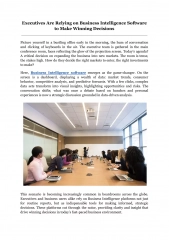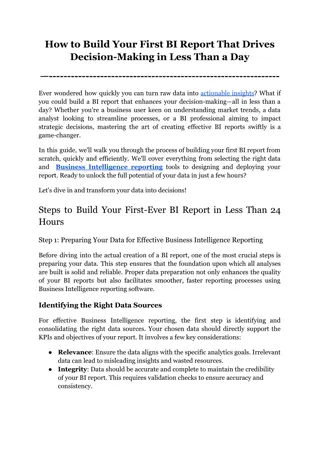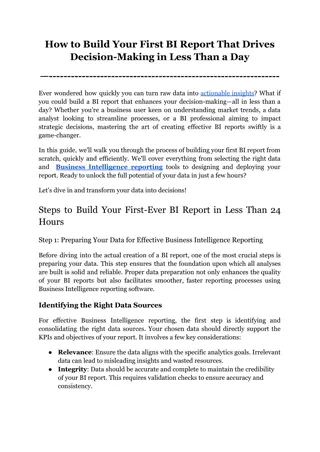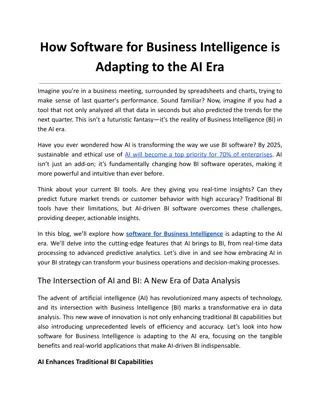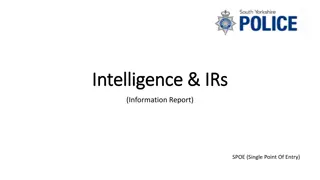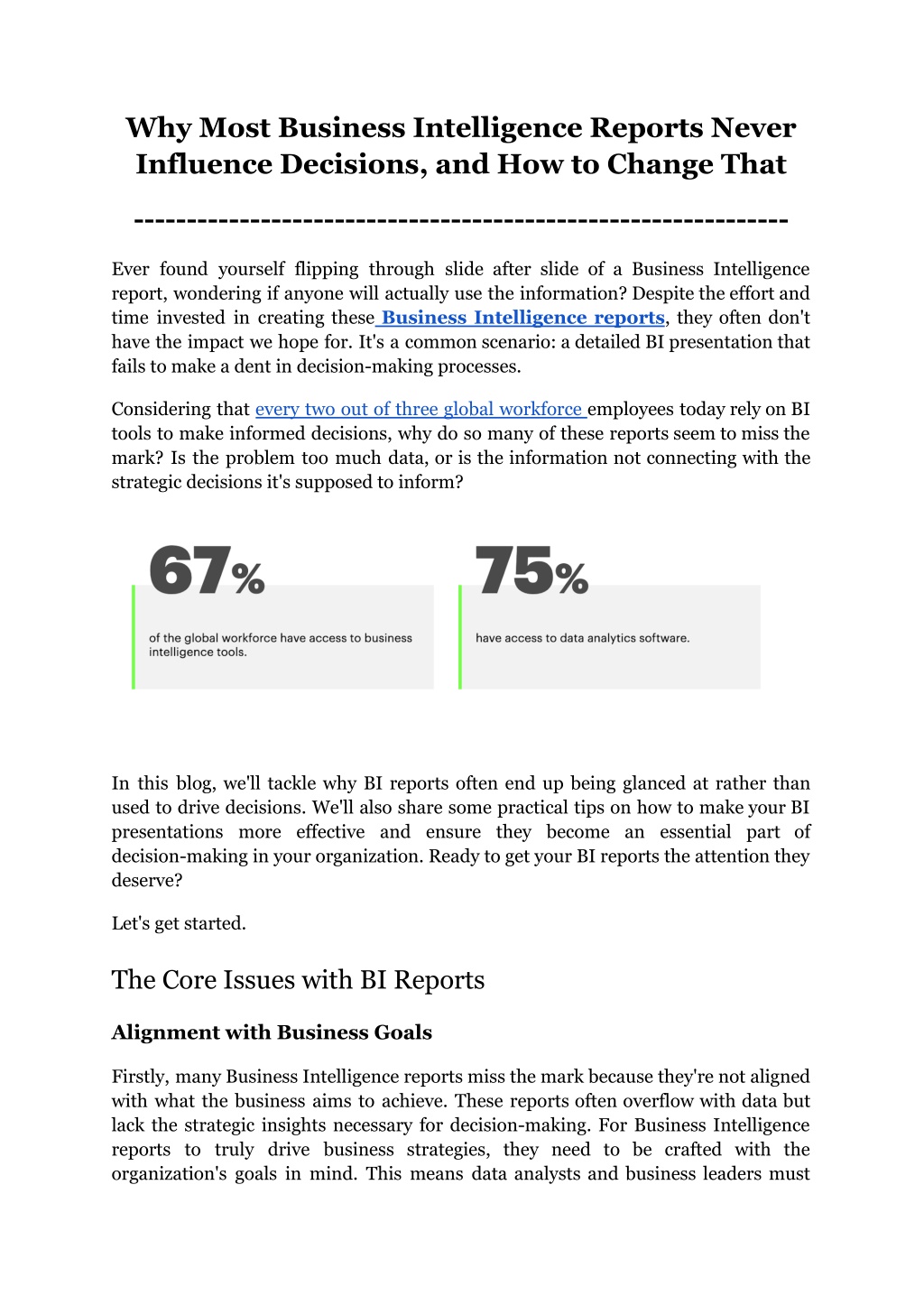
Why Most Business Intelligence Reports Never Influence Decisions, and How to Change That (1)
Discover the crucial insights behind why many Business Intelligence reports fail to impact decision-making and learn actionable strategies to transform your BI reporting.
Download Presentation

Please find below an Image/Link to download the presentation.
The content on the website is provided AS IS for your information and personal use only. It may not be sold, licensed, or shared on other websites without obtaining consent from the author. Download presentation by click this link. If you encounter any issues during the download, it is possible that the publisher has removed the file from their server.
E N D
Presentation Transcript
Why Most Business Intelligence Reports Never Influence Decisions, and How to Change That -------------------------------------------------------------- Ever found yourself flipping through slide after slide of a Business Intelligence report, wondering if anyone will actually use the information? Despite the effort and time invested in creating these Business Intelligence reports, they often don't have the impact we hope for. It's a common scenario: a detailed BI presentation that fails to make a dent in decision-making processes. Considering that every two out of three global workforce employees today rely on BI tools to make informed decisions, why do so many of these reports seem to miss the mark? Is the problem too much data, or is the information not connecting with the strategic decisions it's supposed to inform? In this blog, we'll tackle why BI reports often end up being glanced at rather than used to drive decisions. We'll also share some practical tips on how to make your BI presentations more effective and ensure they become an essential part of decision-making in your organization. Ready to get your BI reports the attention they deserve? Let's get started. The Core Issues with BI Reports Alignment with Business Goals Firstly, many Business Intelligence reports miss the mark because they're not aligned with what the business aims to achieve. These reports often overflow with data but lack the strategic insights necessary for decision-making. For Business Intelligence reports to truly drive business strategies, they need to be crafted with the organization's goals in mind. This means data analysts and business leaders must
work closely to ensure that the reports highlight the key performance indicators (KPIs) that matter most to the business. Also read: How to use SMART Goals to Build Your KPIs Complexity and Information Overload Another issue is the complexity of BI reports. With Business Intelligence reporting tools capable of analyzing vast amounts of data, reports can become overwhelmingly detailed. For decision-makers, cutting through the clutter to find actionable insights is often a challenge. The solution is to simplify BI reports, focusing on the most important data in a clear and straightforward manner. This makes the reports more accessible and ensures that key insights stand out. Hawkins Law Firm overcame the challenge of complex BI reports by using Grow, which simplified data visualization across the firm. Now, everyone from attorneys to finance staff can easily track leads and case statuses, making decisions clearer and more informed. With Grow's help, the firm turned overwhelming data into actionable insights, benefiting the entire team. Data Quality and Relevance Lastly, the effectiveness of BI reporting is closely tied to the quality and relevance of the underlying data. People can make bad choices when they have wrong or old information. Ensuring high-quality and relevant data requires ongoing effort, including robust data governance and regular reviews of the data used in reports. High standards for data quality and relevance mean businesses can rely on their Business Intelligence reports for accurate, timely insights. Transforming BI Reports from Mundane to Influential Turning Business Intelligence (BI) reports from basic data summaries into crucial decision-making tools is vital for modern businesses. This shift not only enhances the value of BI reports but also ensures they play a pivotal role in shaping strategic directions. Here's how to make BI reporting impactful and integral to business success: Align Reports with Strategy The first step in elevating the impact of BI reports is to ensure they're aligned with your business's strategic goals. This means BI reports should go beyond presenting data to offer insights that directly aid decision-making. For example, if improving customer satisfaction is a key goal, then Business Intelligence reports should focus on metrics that shed light on customer behaviors
and preferences. This strategic alignment turns BI reporting into a guiding light for achieving business objectives. Keep It Simple and Relevant Complexity can be overwhelming. Making BI reports simpler and more relevant to their audience is essential. This involves condensing vast amounts of data into clear, actionable insights. Tailoring these reports to meet the specific needs of different departments within the organization ensures that the insights are not just understood but are actionable. For instance, marketing teams might get reports on customer engagement, while finance performance. This customization makes BI reports more practical and valuable for various stakeholders. teams receive insights on financial Focus on Data Quality and Timeliness The reliability of BI reports hinges on the quality and freshness of the data they contain. Ensuring that data is accurate, current, and relevant boosts the credibility of Business Intelligence reports, making decision-making. Implementing strict data governance and utilizing Business Intelligence reporting tools that offer real-time analytics can help maintain data integrity and relevance, empowering businesses to make informed decisions swiftly. them more likely to be used in Utilize Visual Dashboards
The brain gets 90% of its information from what it sees. Visual dashboards can significantly enhance the usability and impact of BI reports. By presenting data visually, these dashboards make complex information accessible and engaging, highlighting key findings at a glance. Designing dashboards that are intuitive and interactive encourages wider use across the organization, making BI insights more actionable and influential. Cultivate a Data-Driven Culture For BI reports to truly influence decisions, a cultural shift towards valuing data-driven decision-making across the organization is necessary. This means encouraging and training teams to incorporate BI insights into their daily decisions and strategies. Leadership plays a crucial role here, setting an example by prioritizing data in their decision-making processes. Fostering this kind of culture ensures that BI reporting becomes a basis of strategic planning and operational efficiency. Learn Why Leadership Loves Grow Conclusion Turning data into strategic decisions comes with a set of challenges. However, when businesses align their Business Intelligence reports with their strategic aims, make reports simple and specific, improve the quality of their data, use visual dashboards for better understanding, and create an environment that values data-driven insights, they can elevate their BI reporting from just a routine activity to a key element in strategic decision-making. This approach not only maximizes data's value
but ensures BI reports significantly influence the important decisions that determine the future of a business. Grow provides an effective solution for businesses aiming to navigate this transformation smoothly. With Grow s intuitive Business Intelligence reporting tools and visual dashboards, companies can easily ensure their data analysis aligns with their strategic objectives, making every data point meaningful. By exploring Grow's 14-day free trial, businesses can begin to refine their BI strategies immediately. Discover how informed, data-driven decisions can enhance your business's strategic direction. Use Grow to integrate data-driven insights seamlessly into your decision-making process. Start today and explore "Grow with Grow.com TrustRadius" for a more informed approach to BI reporting.



